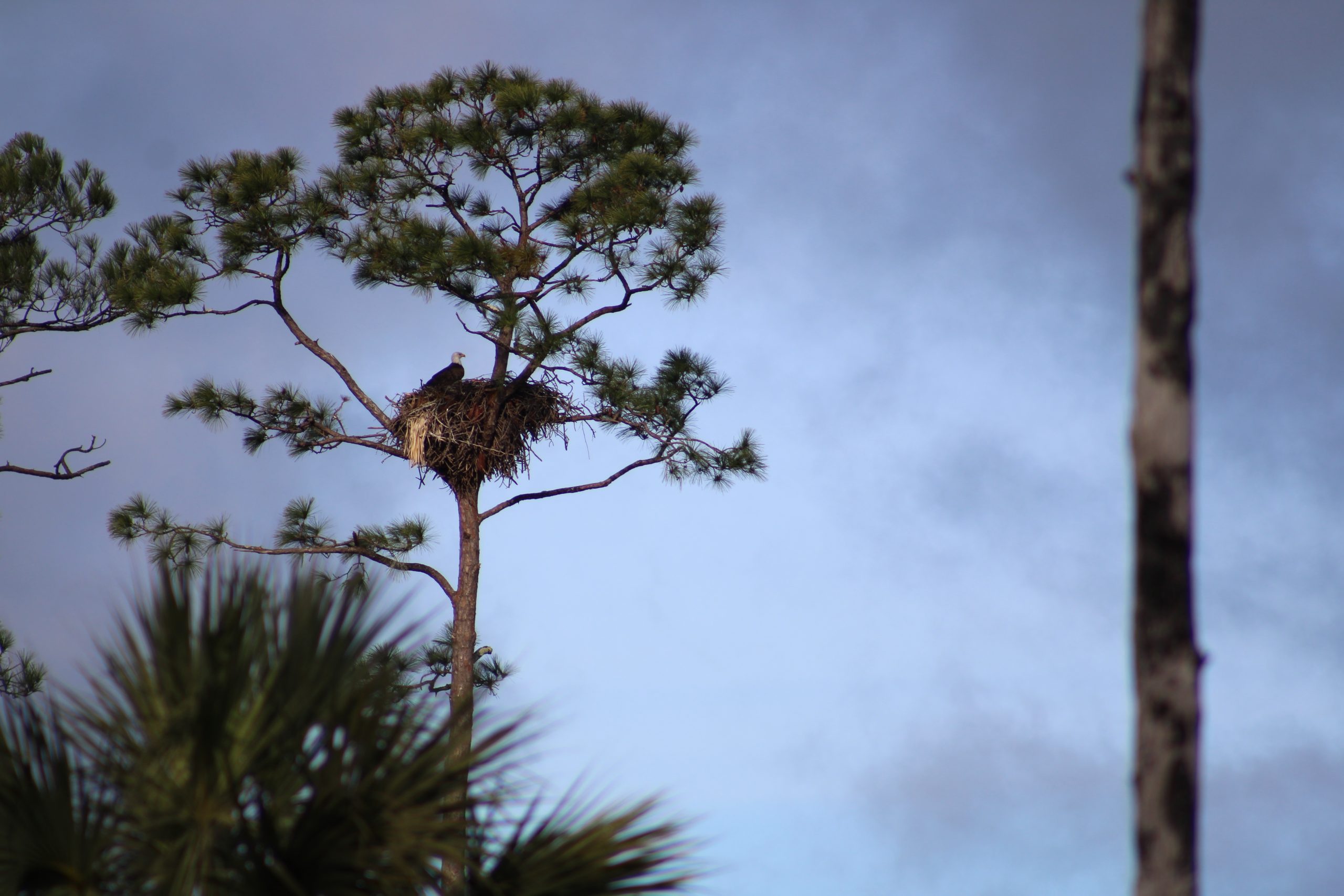Bald eagles are an iconic bird that represents the spirit of the United States. The majestic birds can be found throughout North America. Watching an eagle soar through the sky can be a memorable experience, but spotting eagles nesting is an especially notable.
Let’s explore everything you want to know about eagles nesting.
Key Facts:
- Bald eagles have the biggest nests of all birds, an average nest can weigh around 1,000 pounds!
- Bald eagles make nests across the country. But the largest nesting populations are in Alaska and Florida.
Bald Eagles Nesting: An Overview (Chart)
Here’s a quick look at some of the top facts and features of bald eagle nesting.
| Nesting location | Usually in tall, mature trees. But occasionally, bald eagles will nest on the ground |
| Nest weight | 1 ton (on average) |
| Number of broods per year | One |
| Number of eggs | One to three |
| Nests reused? | Yes |
| Nest material | Sticks, grass, moss, etc |
| Nesting season (Northern) | Early spring |
| Nesting season (Southern) | Late fall to early spring |
Where Do Bald Eagles Nest?
Bald eagles build nests throughout North America. You can find bald eagles nests in the United States, Canada, and northern Mexico.
Nesting Locations
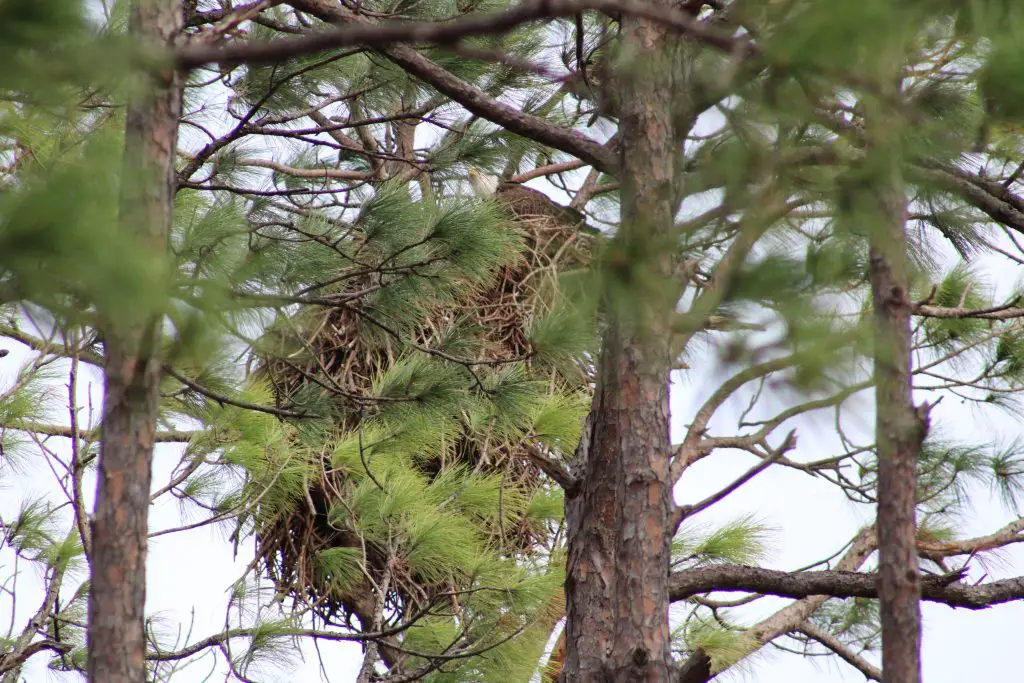
Bald eagles actively select tall trees with sturdy branches near bodies of water. Along coastlines, they choose conifers or deciduous trees that provide excellent visibility for hunting and protecting their nests.
When possible, bald eagles build their nests in old-growth trees. These trees offer a stable foundation and are often located near rivers, lakes, or coastal areas, ensuring a steady supply of fish for their diet. However, most tall, mature trees are a viable option for bald eagles looking for a place to nest. In general, bald eagles will build their nest in a sturdy V-shaped location within the tree. The tree itself provides significant support for the heavy nests that bald eagles tend to build.
If a suitable tree isn’t available, bald eagles may choose to build their nest on the ground. Although a ground nest is less common, it’s not unheard of for these eagles. Bald eagles are more likely to nest on the ground in areas with sparse vegetation, and will often select a secure spot on top of a cliff if a tree is not an option.
Nesting Tree Preferences
Bald eagles nests are heavy, which means the birds tend to be selective when choosing a tree. A scraggly tree won’t provide the necessary support. With that, they favor tall trees with sturdy branches that can support their massive nests and provide a secure foundation.
Coniferous trees, such as pines, firs, and spruces, are frequently selected by bald eagles for nesting. These trees offer strong branches and dense foliage, providing excellent protection and concealment for the eagles and their young.
Bald eagles also choose to build nests in deciduous trees, including hardwoods like oaks, maples, and cottonwoods. These trees provide robust branches and ample coverage during the nesting season, allowing the eagles to safeguard their nests while maintaining good visibility of their surroundings.
Bald eagles tend to choose trees located near bodies of water, such as rivers, lakes, or coastlines. This proximity to water sources ensures easy access to their primary food supply of fish and increases their chances of successful hunting.
What Does a Bald Eagle Nest Look Like?
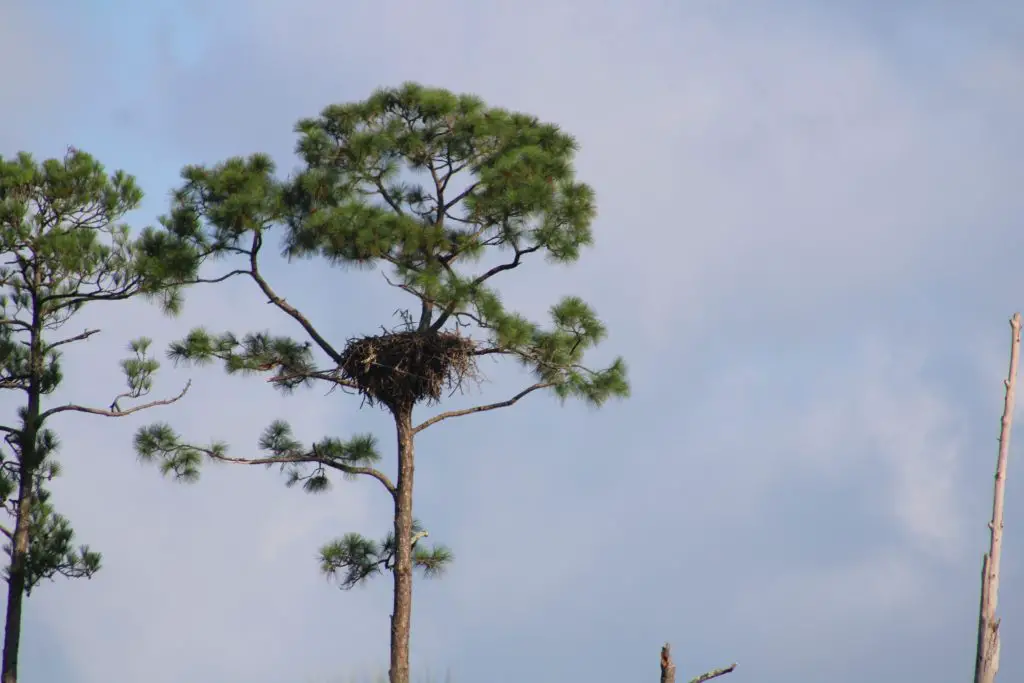
A bald eagle nest, also known as an eyrie, is an impressive structure that reflects the resourcefulness and craftsmanship of these majestic birds. Constructed with precision and care, the nests are typically large and conspicuous.
The nests are broad and deep. Some may even describe the shape as a wine glass without the stem due to the relatively high walls of an eagle nest.
Bald eagle nests are built using a combination of sturdy branches, twigs, and various natural materials. The eagles actively gather these materials, weaving them together to create a solid base. They often add soft lining materials like grass, moss, or feathers to provide comfort and insulation for their eggs and hatchlings.
Size of a Bald Eagle Nest
On average, bald eagle nests have a diameter ranging from 4 to 5 feet (1.2 m to 1.5 m). However, some nests have been documented to exceed ten feet in diameter, making them one of the largest nests built by any bird species. The size of the nest increases over time as the eagles continuously add new materials to reinforce and expand their dwelling.
The sheer weight of a bald eagle nest is equally astonishing. These nests can weigh several hundred pounds, with some estimates surpassing one ton. This substantial weight is a testament to the eagles’ ability to construct sturdy structures that withstand various weather conditions and provide a secure habitat for their young.
Height of a Bald Eagle Nest
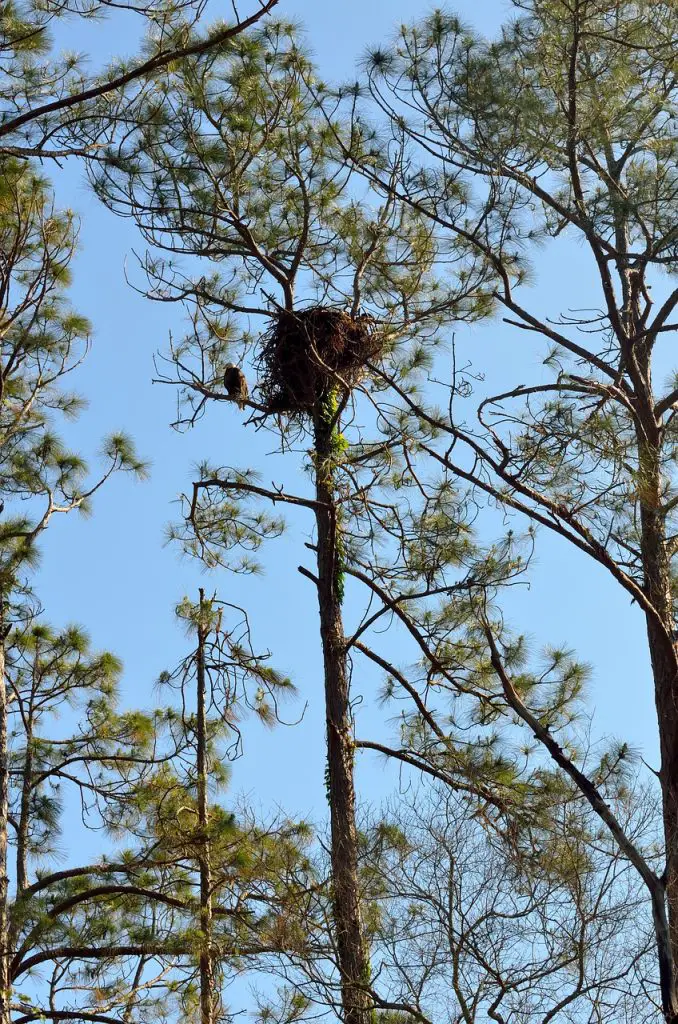
Bald eagle nests are often strategically positioned high in trees, typically on tall branches or near the crown of the tree.
On average, bald eagle nests are situated between 50 to 125 feet above the ground. However, their placement can vary depending on the availability of suitable trees and the specific geographical location. In some instances, eagle nests have been observed as low as 20 feet or as high as 200 feet from the ground.
This elevated placement offers the eagles a clear vantage point to monitor their surroundings, ensuring the safety and security of their nest and offspring. But in some cases, bald eagles will choose to nest on the ground if a suitable tree isn’t available.
How Do Bald Eagles Build a Nest?
The eagles start by selecting a suitable tree, typically a tall and robust one, with strong branches. They then gather an assortment of materials, including sturdy sticks, branches, and twigs, often snapping them off from nearby trees or collecting them from the ground.
With precision and care, the eagles intertwine and weave the sticks together, creating a solid foundation for the nest. They continually add layers of sticks, gradually building up the structure. To enhance stability, the eagles secure the sticks by interlocking them and using their beaks to maneuver and adjust the placement.
As the nest takes shape, the eagles incorporate softer materials to line the interior. They gather grass, moss, leaves, and even feathers, arranging them in the center of the nest to create a comfortable and insulating bed for their eggs and hatchlings.
How Long Does It Take for a Bald Eagle to Build a Nest?
On average, it takes bald eagles several weeks to several months to complete the construction of their nest. The exact duration can vary depending on factors such as the availability of suitable materials, the experience of the pair, and the level of maintenance required for an existing nest.
Will Bald Eagles Reuse Their Nest?
The nest-building process continues throughout the eagles’ lives. They regularly maintain and reinforce their nests, adding fresh materials each breeding season. Each year, the eagle may increase the nest size by 1 to 3 feet. Over time, these nests can become massive structures, sometimes exceeding ten feet in diameter and weighing hundreds of pounds.
A single nest in Ohio was used for 34 years in a row. But a storm eventually blew the massive structure out of the tree.
Will Bald Eagles Use The Nest Multiple Times in a Year?
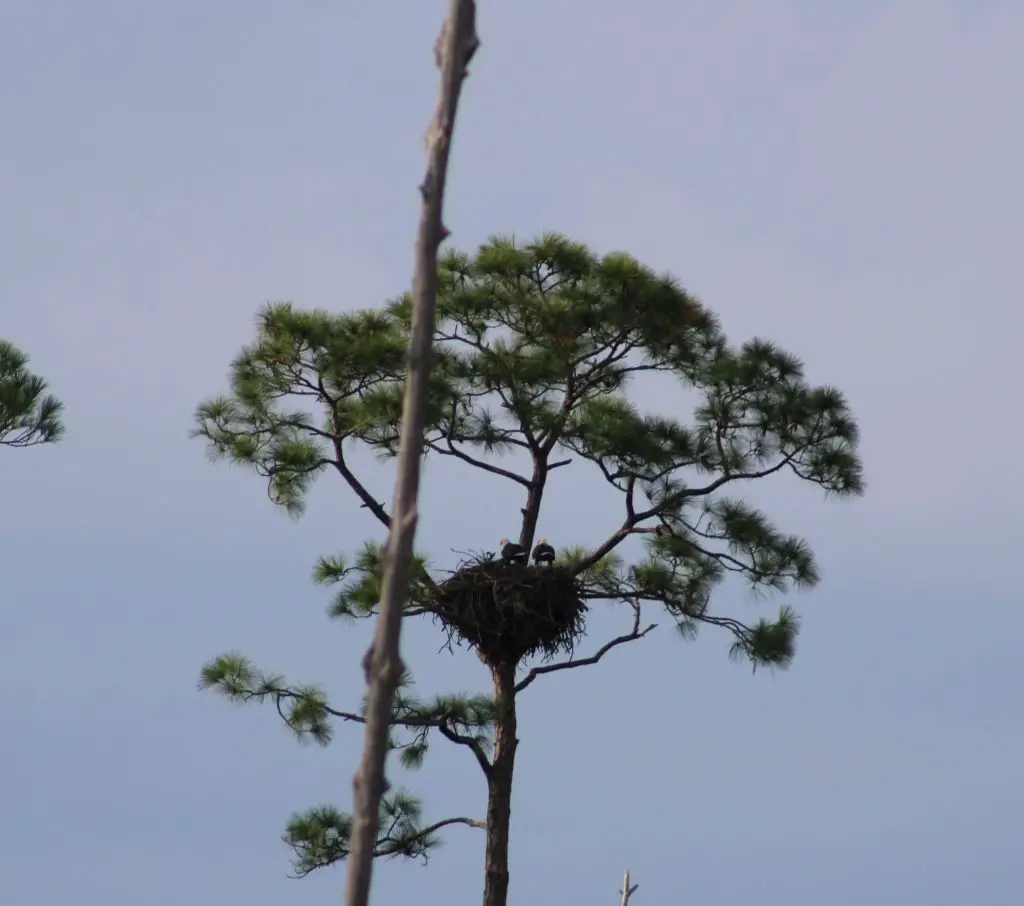
No. Bald eagles usually only care for one brood of young in a season. With that, a pair of bald eagles usually won’t use the same nest multiple times in the same year.
Eagle Nesting Seasons
The exact timing of bald eagle nesting can vary depending on the geographical location and local climate. But, in general, eagles time to nest when the conditions are best for raising young. Whenever the birds have the best access to food is likely when they will build a nest.
In the southern portion of their range, bald eagles may start nesting in late summer or late spring. The better weather conditions give the birds a large window for success. For example, I’ve seen bald eagles build nests on the Florida coastline in November and Feburary, it seems to vary based on the individual eagle.
In contrast, eagles in the northern population have more limited nesting seasons. In general, the northern eagles start building their nest in early spring.
Egg Laying Months
When bald eagles lay eggs also vary based on their location. Typically, birds in the northern populations lay eggs from late April to May. But in the southern populations, the birds tend to lay eggs between December and January.
Here’s a breakdown of egg laying observations in a few different locations:
- Florida: October to April
- Saskatchewan: mid-April
- Arizona: January to February
The southern birds have more flexibility on when they can safely lay their eggs outside of harsh winter conditions.
Eagles Nesting Duration
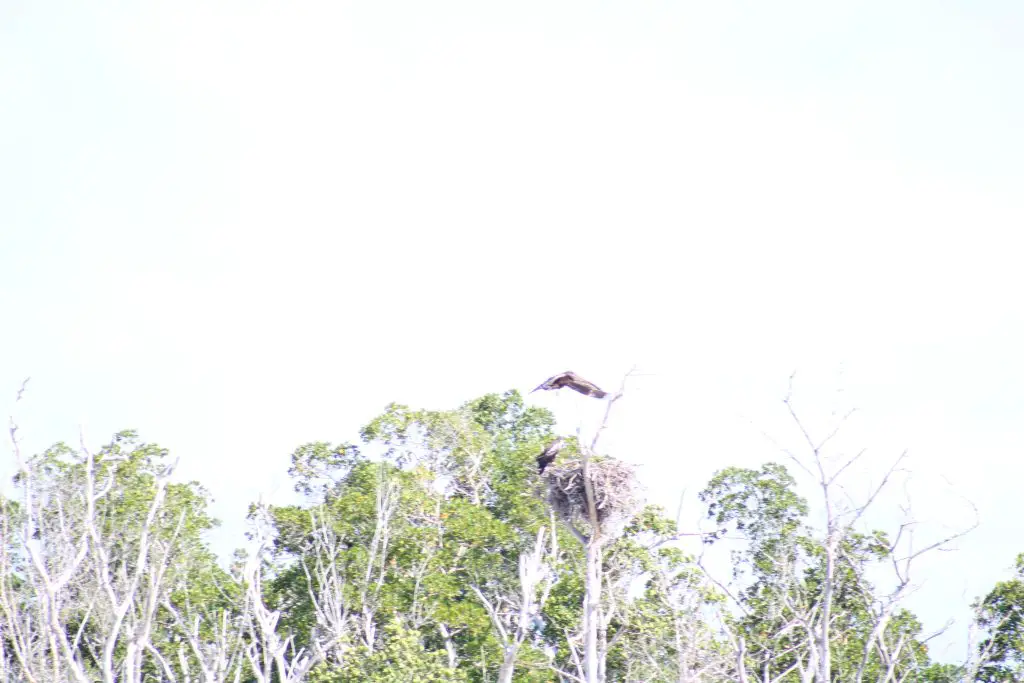
Bald eagle chicks, after hatching from their eggs, spend a significant amount of time in the nest under the watchful care of their parents. The duration they remain in the nest, also known as the fledging period, is essential for their growth and development.
On average, bald eagle chicks stay in the nest for approximately 10 to 12 weeks. During this time, they undergo rapid growth and acquire the necessary strength and skills to survive independently.
In the early stages, the chicks rely entirely on their parents for food and protection. The adult eagles diligently provide a steady supply of prey, primarily fish, and diligently guard the nest from potential threats.
As the weeks pass, the chicks begin to strengthen their wings and practice their fledgling skills. They engage in “branching,” which involves venturing onto nearby branches surrounding the nest, honing their balance and coordination.
Eventually, the eaglets reach a stage where they are ready for their first flight attempts. This momentous event, known as fledging, marks the beginning of their journey towards independence. The fledging process may take several days to a week as the chicks gain confidence and proficiency in their flight abilities.
Even after fledging, the eaglets tend to stay around the nest (or at least in the area) for 6 to 8 months. After that, the fully-fledged eagles branch out on their own to establish their very own territory. This might be nearby or far from home. Immature bald eagles are known to venture far from their birthplace. For example, some young birds from California have made their home in Alaska.
Bald Eagles Nesting Fun Facts
Let’s take a look at some of the most interesting facts about bald eagle nests.
- Largest nest: The largest bald eagle nest was found in St. Petersberg, Florida. It was 10 feet in diameter and 20 feet tall, it weighed around 6,000 pounds!
- Longevity: A single bald eagle nest was used consecutively for 34 years in Ohio, before it got blow out of the tree.
- The majestic turkey? Benjamin Franklin wanted the wild turkey to be America’s emblem. But the Bald eagle won that competition!
- Thieves! Bald eagles have a habit of stealing fish from other birds of prey. While bald eagles are perfectly capable of catching their own dinner, sometimes they prefer an easy meal by stealing from a fish eagle.
- Commitment: Mating pairs tend to return to the same nest year after year. Both the male and female work on building the nest.
Eagles Nesting: Frequently Asked Questions
You have questions about bald eagles nesting. I have answers.
What do Bald eagle eggs look like?
Bald eagle eggs are generally white and have a smooth texture. They are about the size of a medium-sized chicken egg, typically measuring around 2.5 to 3 inches in length.
How much does a Bald eagle nest weigh?
The weight of a bald eagle nest can vary significantly depending on its size and materials used. On average, bald eagle nests can weigh several hundred pounds, with some nests reaching weights of over a ton.
Do Bald eagles nest in Florida?
Yes, bald eagles do nest in Florida. Florida is home to a population of bald eagles, and the state has numerous suitable habitats for these birds, including wetlands, coastal areas, and lakes.
What is an eagle’s nest called?
An eagle’s nest is called an eyrie. This term refers to the large nest constructed by eagles for breeding and raising their young.
How do you identify an eagle nest?
Identifying an eagle nest can be done by observing its characteristics. Eagle nests are typically large and conspicuous, built in tall trees or on cliffs. They often have a sturdy structure made of sticks and may be lined with softer materials like grass or feathers. The presence of a large nest in an elevated location, often near water sources, is a strong indicator of an eagle’s nest.
Final Take on Bald Eagles Nesting
Bald eagles are undeniably beautiful birds with interesting nesting habits. As you look for eagle nests on your very own wildlife quest, the unique nature of these nests should give you a clue as to what’s inside.
